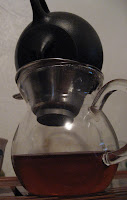
The pot is made out of Duan ni clay, "a yellow or green Zisha, literally Satin Mud." The walls are thinner than my other pots, which is a bit of a scare. I don't think this pot can take a fall. I got it from Rishi-Tea, who packaged it very well, very safe. I seasoned it very mildly. I ran a lot of hot tap water through it, shaking the water inside to disturb loose particles. Then I brewed a few steeps of Wuyi Amber in it, leaving the steeps in for longer than I would have, had I been planning on drinking it. Afterwards, I brewed a few pots of some 2005 Shui Xian, which came out thicker, more viscous, and sweeter than when brewed in a glazed porcelain gaiwan.

I think the quality of the clay is very high. When I got it, I performed the "sniff test," which is a simple test to determine quality of Yixing clay. I learned of this test through Jason Fasi, aka BearsBearsBears. It is very simple. You start by rinsing the pot out well to get leftover dust and powder from the manufacture out. Then you pour near boiling water into the pot, then back out again, and take a good whiff of the smell that the clay puts off. There are basically three possibilities. If the clay smells like chemicals, then it has been mixed with paint or synthetics. If it smells like mud, then it's been blended with low-quality clay. Real yixing clay will smell like hot rocks or sand. If it's real, then the hot rock smell will be very pronounced, so much so that it may seem a little too intense.

This pot passed with flying colors. The smell was very strong and was exactly like hot rocks. So even though it's a little thinner than I'd like, the quality of the clay was better than I expected.





























